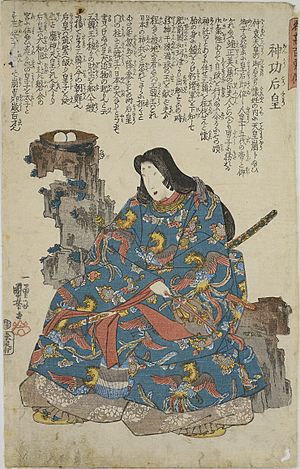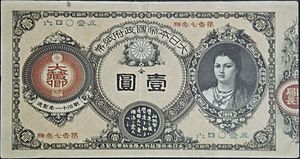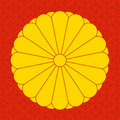Empress Jingū facts for kids
Quick facts for kids Jingū |
|
|---|---|
| Empress of Japan | |

Empress Jingū
|
|
| Reign | legendary |
| Predecessor | Chūai |
| Successor | Ōjin |
| Born | legendary |
| Died | legendary |
| Burial | Saki no Tatanami no ike no e no Misasagi (Nara) |
Empress Jingū (神功天皇, Jingū-tennō), also known as Empress-consort Jingū (神功皇后, Jingū-kōgō), was a legendary empress of Japan. She is famous in Japanese stories. Even though her name was once part of the official list of Japanese rulers, she is now mostly seen as a regent. A regent is someone who rules a country when the main ruler (like an emperor) is too young or unable to rule.
Many historians believe that the stories about Empress Jingū are more like myths than real history. The name Jingū-tennō was given to her much later, after she was believed to have lived. We don't have exact dates for when she lived or ruled. The names and order of the early emperors were only officially confirmed much later, during the time of Emperor Kammu, who was the 50th ruler of Japan.
Stories about Jingū
Jingū is mostly known from old Japanese books like the Kojiki and Nihonshoki. These books tell many stories about her.
Jingū was the main wife of Emperor Chūai. Her son later became known as Emperor Ōjin. Another old book, the Gukanshō, also mentions her. However, she is not listed as someone who was born into the direct line of emperors. This means her role was special and different from other empresses.
What Jingū did
Even though we don't have many facts about Jingū, it doesn't mean she never existed. There is very little information about Japanese rulers before Emperor Kimmei, who was the 29th emperor.
After Emperor Chūai died, Jingū became a regent. She ruled Japan until her son, Ōjin, was old enough to take the throne. This happened because of a message from the gods, given at a Shinto shrine called Sumiyoshi-jinja.
After her time
Jingū's official name after her death, called a posthumous name, was decided many centuries after she was believed to have lived.
The Imperial Household Agency, which manages the Japanese imperial family, says that the empress's final resting place is in a large tumulus (a mound of earth) called a kofun. This tomb is in Nara. People still honor Jingū at a special memorial Shinto shrine (misasagi) in Nara.
- In 1883, Empress Jingū became the first woman and the first person to have her picture on Japanese paper money. However, the picture of Jingū used on the money was not a real portrait. It was an imagined drawing made by an artist named Edoardo Chiossone.
For many centuries before the Meiji period (which started in 1868), Jingū was thought to be the 15th ruler of Japan. This was based on the traditional order of rulers. But today, her name has been removed from the official list of emperors of Japan. Instead, her son, Emperor Ōjin, is now considered the 15th emperor in the official list.
Related pages
- Emperor of Japan
- List of emperors of Japan
- Japanese Imperial family tree
- Jingū Seamount
- Japanese empresses
- Sumiyoshi-jinja - a shrine connected to her story
- Bank of Japan: Empress Jingū on bank note (1883)
- Stamp library: Empress Jingū on 10-yen violet postage stamp (1924)
- Stamp library: Empress Jingū on 10-yen green postage stamp (1924)
| Preceded by Emperor Chūai |
Legendary Empress Consort of Japan: Jingū 209-269 (traditional dates) |
Succeeded by Emperor Ōjin |
Images for kids
-
Empress Jingū, a woodblock print by Tsukioka Yoshitoshi (1880)
See also
 In Spanish: Jingū para niños
In Spanish: Jingū para niños






